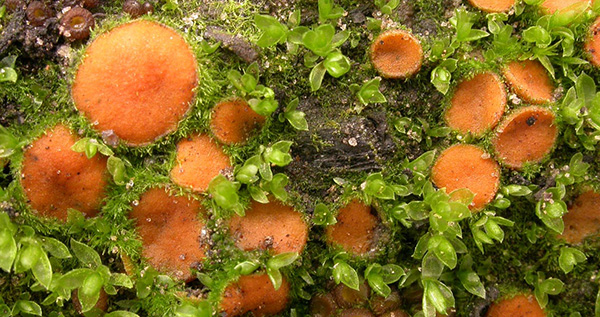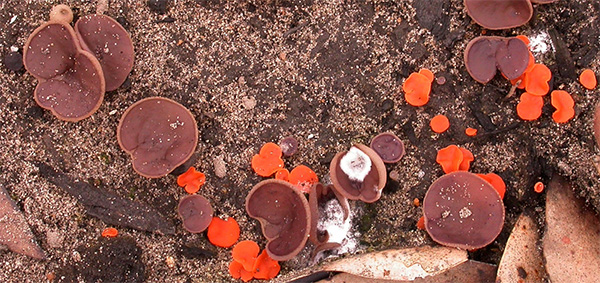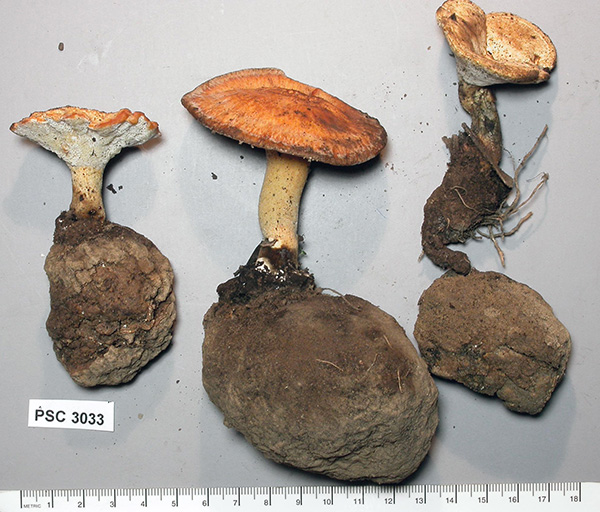
Orange disc fungus, Byssonectria fusispora, surrounded by mosses. Photo: D. Catcheside.
Fungi are essential in all ecosystems, acting as recyclers, helpers of almost all plants and improving soil health. After fire, much of the organic material in soils may have burnt, leaving a blackened mass of fine, silty particles and ash. The ash is highly alkaline and unfavourable for plant regrowth. The fungi help in restoration of soil health, as recyclers of burnt litter and wood and as partners with plants in re-establishing the vegetation.

Two disc fungi, orange Pulvinula archeri, brown-lilac Peziza tenacella. Photo: D. Catcheside.
A group of fungi whose spores germinate almost immediately after fire are the disc fungi (e.g. Peziza and Pulvinula, image above). These act as colonisers. Their fine thread-like hyphae bind soil particles, stabilising the soil and helping to reduce erosion. They change the highly alkaline ash (with a pH of up to 10) to soils which are approximately neutral (pH 7). Structurally, the hyphae form a network, a ‘scaffolding’, improving soil aeration and water percolation. The often dense carpets of disc fungi covering the bare soil not only reduce erosion but also provide protection for small plants such as mosses, grasses and herbs (see top image). As the fungal hyphae and plant roots grow their developing networks increase movement of gases and water through the soil. Other groups of fungi are saprotrophs, breaking down and recycling burnt litter and wood.

Coprinellus angulatus, a saprotrophic fungus (left image). Stereum hirsutum, a saprotroph on wood (right image). Photos: D. Catcheside.

Pam Catcheside and Danielle Calabro with a sclerotium of Laccocephalum mylittae. Photo: D. Catcheside.
There is a definite succession of fungi after fires.
Amongst the first to appear, often only a day or two after fire, are strange, hard, mushroom-like fungi with pores, not gills in the genus Laccocephalum (see image at bottom of this post). Their fruit-bodies grow from an underground storage-organ called a sclerotium. The sclerotium of Laccocephalum mylittae, native bread, was eaten by Aborigines (image on right). It may weigh up to 20 kg.
Yellow, orange, brown and black disc fungi appear. Some species fruit only in the first year after fire, others in the second and some for several years. As litter builds up recycling fungi break it down returning nutrients to the soil.
Mycorrhizal fungi (e.g. from the genus Laccaria, image below), which form symbiotic relationships with plants become re-established, collecting nutrients and water for the partner plant and receiving energy-giving sugars in return. Gradually, the web of life with all its complex communication systems regains momentum, habitats are re-established, insects and other animal life return and natural cycles continue.
We observed this pattern after the 2007 bushfires on Kangaroo Island. Since Flinders Chase National Park is relatively self-contained, weeds which often invade bare areas did not threaten the native systems. Keeping out weeds after a fire is a major concern.

Laccaria sp., a mycorrhizal fungus. Photo: D. Catcheside.
Another concern is that it takes time for the bush to re-establish itself, some studies showing that it takes at least five years but this time lapse varies with different habitats. We have found that most groups of fungi have returned to pre-fire levels. It is now 12 years since the last major fires on the island and Kangaroo Island has shown itself to be resilient.

Laccocephalum sp. showing swollen sclerotium. Image of herbariumspecimen PSC3033 before drying. Photo: D. Catcheside.
Further reading
Atlas of Living Australia. Geopyxis carbonaria (Alb. & Schwein) Sacc.
Catcheside, P. (2009). Phoenicoid discomycetes in Kangaroo Island. Fungimap Newsletter 38: 5-8.
George, P. (2008). Fungimap survey on Kangaroo Island. Fungimap Newsletter 36: 13-15.
Kalotas, A.C. (1996). Aboriginal knowledge and use of fungi. In Orchard, A.E. (Exec. Ed.), Mallett, K. & Grgurinovic C. (Vol. Eds.). Fungi of Australia, Vol. 1B: Introduction-Fungi in the Environment. (Australian Biological Resources Study, Canberra).
McMullan-Fisher, S. J. M., May, T. W. & Keane, P. J. (2002). The macrofungal community and fire in a Mountain Ash forest in southern Australia. Fungal Diversity 10: 57-76.
Robinson, R.M. (2009). Laccocephalums on Kangaroo Island. Fungimap Newsletter 37: 6-7.
Robinson, R. (2007). Laccocephalum mylittae – Native Bread. (Dept of Environment & Conservation: Manjuimup). [Fungus Factsheet 18/2007].
Spooner, B. & Roberts, P. (2005). Fungi. (Collins: New Naturalist Library).
Yales, D. (2019). Fire-spawned forest fungi hide out in other organisms, study finds. PHYS.ORG website.
Written by State Herbarium Hon. Research Associate Pam Catcheside.
